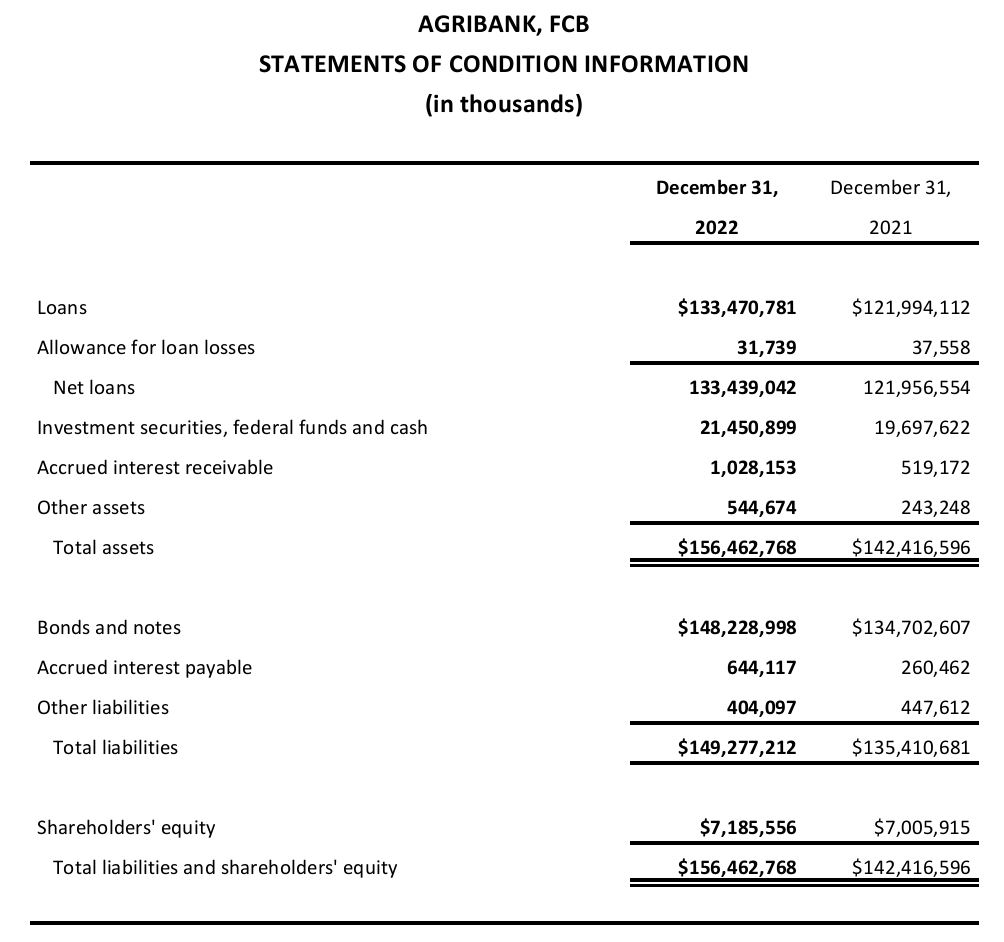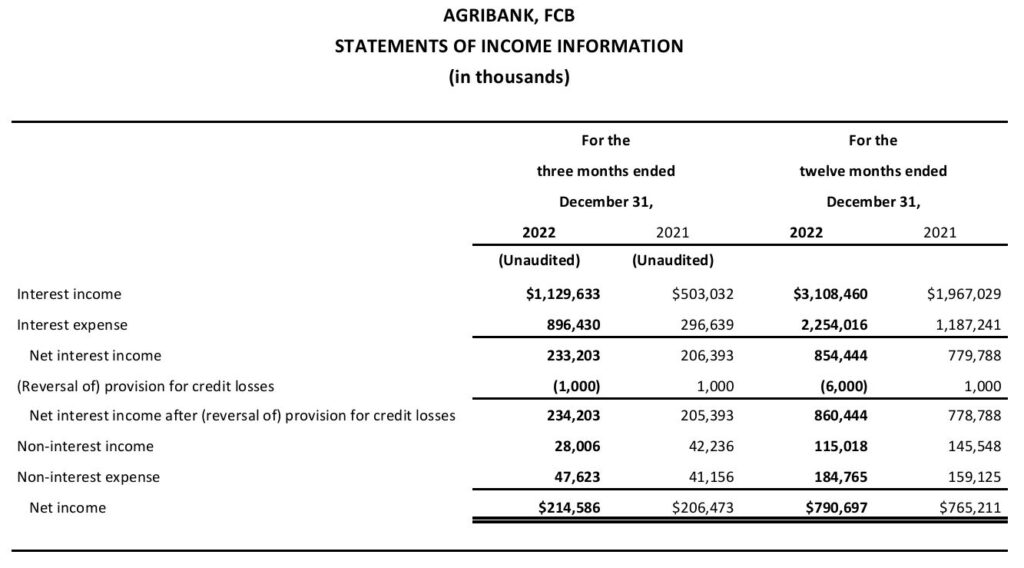ST. PAUL, Minn., March 2, 2023 – Today, St. Paul-based AgriBank announced financial results for the fourth quarter and full year of 2022, with strong profitability, credit quality, and liquidity and capital.
Highlights:
Profitability: Net income remained strong at $790.7 million for the year ended December 31, 2022. AgriBank’s year-to-date return on assets (ROA) ratio of 53 basis points was above the target of 50 basis points.
Credit quality: Total loan portfolio credit quality was strong, with 99.6 percent of loans classified as acceptable at December 31, 2022, compared to 98.3 percent at December 31, 2021.
Liquidity and capital: End-of-the-quarter liquidity was 159 days, well above the regulatory requirement. Capital also remained well above the regulatory minimums and company targets.
“AgriBank’s strong net income for 2022 reflects the strong financial performance by the Farm Credit lenders we support,” said Jeffrey Swanhorst, AgriBank chief executive officer. “Under our cooperative structure, we returned a record $773.3 million in earnings primarily to those lenders—our customer/owners—in the form of cash and stock patronage distributions. Those funds ultimately benefit the farmers, ranchers and other borrowers throughout the rural communities we serve.”
2022 Results of Operations
Net interest income was $854.4 million for the year ended December 31, 2022, an increase of $74.7 million, or 9.6 percent, compared to the same period of the prior year. Net interest income increased mainly due to the positive impact of non-interest bearing funding driven by the sharp rise in interest rates, loan growth in the retail portfolio, and increased spreads on investment securities.
Non-interest income was $115.0 million for the year ended December 31, 2022, a decrease of $30.5 million, or 21.0 percent, compared to the same period of the prior year. As interest rates have risen, loan prepayment and conversion activity have continued to slow, resulting in lower fee income. Partially offsetting these decreases, mineral income has increased due to sustained higher oil prices.
Non-interest expense was $184.8 million for the year ended December 31, 2022, an increase of $25.6 million, or 16.1 percent, compared to the same period of the prior year. The increase was primarily driven by an increase in loan servicing fees as AgriBank’s pool programs have continued to expand, as well as higher Farm Credit System Insurance Corporation insurance premiums.
Loan Portfolio
Total loans were $133.5 billion at December 31, 2022, an increase of $11.5 billion, or 9.4 percent, compared to December 31, 2021. This increase was primarily attributable to wholesale loan growth and, to a lesser extent, increases in retail loans.
AgriBank’s credit quality reflects the overall financial strength of District Associations and their underlying portfolios of retail loans. AgriBank’s portfolio was composed of 99.6 percent loans classified as acceptable as of December 31, 2022, compared to 98.3 percent at December 31, 2021. Loans classified as acceptable represent the highest-quality assets. The credit quality of AgriBank’s retail loan portfolio increased to 95.8 percent classified as acceptable at December 31, 2022, compared to 95.4 percent acceptable at December 31, 2021.
Agricultural Conditions
On February 7, 2023, the U.S. Department of Agriculture’s Economic Research Service (USDA-ERS) released its initial forecast of the U.S. aggregate farm income and financial conditions for 2023 and updated its 2022 forecast. The revised 2022 net farm income (NFI) forecast of $162.7 billion represented a $21.8 billion nominal increase from 2021, up 15.5 percent, with income increasing for the third consecutive year. When adjusting for inflation, the 2022 NFI forecast would be at the highest level since 1973. The initial 2023 NFI projection of $136.9 billion would represent a nominal decline of $25.8 billion, or 15.9 percent, from the revised 2022 NFI forecast. While the initial NFI projection for 2023 is down substantially from 2022, if realized, that income level would still surpass the 20-year average estimated real net farm income level by $28.7 billion or 26.6 percent and would mark the fifth highest level since the 1970s in real terms.
Despite the high input cost environment for crop producers and high feed costs for the animal protein sector, the U.S. agriculture sector is positioned well in 2023. The farm sector balance sheet remains strong and while sector working capital is expected to deteriorate in 2023, many producers’ working capital positions should remain favorable. Many factors, including weather, trade, government and monetary policy, global agricultural production levels, and pathogenic outbreaks in livestock and poultry, may keep agriculture market volatility elevated for the next few years. Implementation of cost-saving technologies, marketing methods and risk management strategies will continue to cause a wide range of results among the respective agricultural producers.
Capital Resources and Liquidity
Total capital remained strong at $7.2 billion as of December 31, 2022, an increase of $179.6 million compared to December 31, 2021. This increase was driven primarily by strong net income and net stock issuances, which positively impacted shareholders’ equity. These increases were mostly offset by unrealized investment losses (primarily on U.S. Treasury securities and fixed-rate U.S. government guaranteed mortgage-backed securities) related to the rapid increase in interest rates in 2022. Additionally, patronage distributions declared offset the increases in equity. AgriBank exceeded all regulatory capital minimum requirements, including additional regulatory buffers.
Cash and investments totaled $21.5 billion and $19.7 billion at December 31, 2022 and December 31, 2021, respectively. AgriBank’s end-of-the-period liquidity position represented 159 days coverage of maturing debt obligations, which supports operational demands, and was well above the 90-day minimum established by AgriBank’s regulator.
About AgriBank
AgriBank is part of the customer-owned, nationwide Farm Credit System. Under Farm Credit’s cooperative structure, AgriBank is primarily owned by local Farm Credit Associations, which provide financial products and services to rural communities and agriculture. AgriBank obtains funds and provides funding and financial solutions to those Associations. AgriBank and those Associations comprise the AgriBank District. The District covers a 15-state area stretching from Wyoming to Ohio and Minnesota to Arkansas. For more information, visit www.AgriBank.com.
Forward-Looking Statements
Any forward-looking statements in this press release are based on current expectations and are subject to uncertainty and changes in circumstances. Actual results may differ materially from expectations due to a number of risks and uncertainties. More information about these risks and uncertainties is contained in AgriBank’s annual report, which is available approximately 75 days following the end of the year. AgriBank undertakes no duty to update or revise any forward-looking statements, whether as a result of new information, future events or otherwise.




